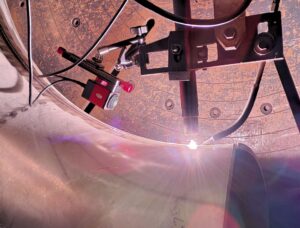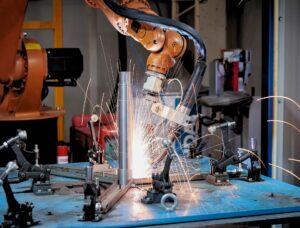Robotic welding has revolutionized the manufacturing industry, offering unparalleled precision, speed, and efficiency. From automotive assembly lines to aerospace fabrication, robotic welding systems are increasingly used to produce high-quality welds. This blog will delve into the benefits, challenges, and diverse applications of robotic welding and how Mecaweld’s advanced welding cameras complement these systems to ensure superior results.
What is Robotic Welding?
Robotic welding involves using programmable robots equipped with welding tools to perform automated welding tasks. These systems are designed to enhance consistency, reduce errors, and boost productivity in industries where precision is critical.
Benefits of Robotic Welding
Improved Precision and Quality
- Robots perform repetitive tasks with unmatched accuracy, reducing weld defects such as porosity and undercuts.
- Mecaweld’s welding cameras enable real-time monitoring, ensuring weld quality and precision at every stage.
Increased Efficiency
- Robotic systems operate continuously, significantly reducing production time.
- High-speed welding processes like laser or MIG welding are optimized with automation.
Cost Savings
- Reduced material waste due to fewer defects.
- Lower labor costs as fewer manual welders are required.
Enhanced Safety
- Robots handle hazardous environments and tasks, minimizing risks for human workers.
Challenges of Robotic Welding
High Initial Investment
- Robotic welding systems require significant upfront costs, including installation and training.
Complex Setup and Programming
- Setting up and programming robotic welders demands specialized skills and knowledge.
- Mecaweld’s weld cameras simplify troubleshooting and setup by providing a clear view of weld quality.
Material and Task Limitations
- Robots may struggle with complex welds on varying materials or in challenging positions.
- Integration with advanced tools like Mecaweld’s welding cameras enhances their adaptability.
Maintenance Requirements
- Regular maintenance is critical to ensure long-term performance.
Applications of Robotic Welding
Automotive Industry
- Robotic systems weld vehicle components with consistent quality and speed.
- Spot and MIG welding are widely used for assembling car bodies and frames.
Aerospace and Defense
- Precision welding of lightweight materials like aluminum and titanium is essential for aircraft and spacecraft manufacturing.
- Robotic TIG and laser welding are common in this sector.
Construction
- Welding structural steel components for bridges, buildings, and pipelines.
- Automation improves efficiency in large-scale construction projects.
Electronics and Electrical
- Welding delicate components in circuit boards and batteries.
- Robotic welding ensures precision and prevents damage to sensitive parts.
Shipbuilding
- Welding thick steel sections for ships and submarines.
- Flux-cored arc welding (FCAW) robots streamline these processes.
How Mecaweld Enhances Robotic Welding
Mecaweld’s welding cameras are the perfect companion for robotic welding systems:
- Real-Time Monitoring: Ensures weld quality by detecting defects like porosity or improper fusion.
- Enhanced Precision: High-definition visuals allow for precise adjustments during the welding process.
- Data Collection: Weld cameras record the entire process for quality assurance and training purposes.
- Seamless Integration: Mecaweld’s cameras are designed to integrate easily with robotic systems, enhancing their performance and versatility.
Tips for Implementing Robotic Welding
- Evaluate Your Needs: Assess whether robotic welding suits your production volume and complexity.
- Train Your Team: Invest in training for operators and technicians to manage robotic systems effectively.
- Use Advanced Tools: Incorporate Mecaweld’s welding cameras for better monitoring and troubleshooting.
- Regular Maintenance: Ensure your robotic system stays in optimal condition with routine checks.
Conclusion
Robotic welding represents the future of manufacturing, delivering precision, speed, and efficiency across various industries. While challenges exist, the benefits far outweigh the drawbacks when paired with the right tools, such as Mecaweld’s welding cameras. These advanced monitoring systems ensure high-quality results and enable seamless integration with robotic systems.
Ready to revolutionize your welding process? Contact Mecaweld today to learn more about our innovative solutions.



